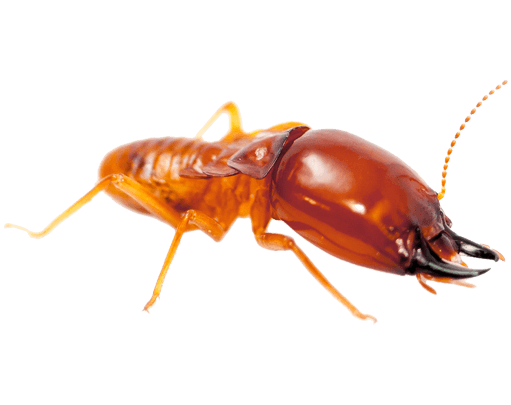
TERMITES
Termites can not only wreak havoc on the infrastructure of your home, but they can also be quite unsettling. The worst part of this pest infestation – they cause lots of damage around your home, without leaving any visible evidence behind.
Unfortunately, all homes are susceptible to termite infestations. Before you realize it, they can cause extreme damage to your home, which could cost you thousands to fix. That’s why we recommend our Termite Shield Service to ensure your home is always safe.
If you think you might have a termite infestation, or you’re interested in preventing one, call today for a free quote!
Schedule a FREE Estimate
WHAT IS A TERMITE?
Termites are an incredibly old (think Late Jurassic period) detritophagous eusocial insect that feast on a variety of decaying plant matter such as wood, leaf litter, and soil humus. Sometimes referred to as “white ants”, termites are soft-bodied and pale in color, appearing very similar to large white ants although only distantly related. They can be found throughout most of the world and are especially prevalent in tropical regions. Unsurprisingly, they are extremely rampant in the United States and can be found in 49 out of the 50 with only Alaska remaining termite-free.
The most common termite species found in the U.S. is the native subterranean termite, while other less common species include the drywood termite, dampwood termite, conehead termite, and highly invasive Formosan termite. When most homeowners think of termites, they are likely picturing the subterranean termite. These termites are incredibly common in homes and are often the cause of more extensive (and expensive) home damage. The second-most common household termite is the drywood termite, which thrives on consuming hard, dry wood like structural beams and timbers.
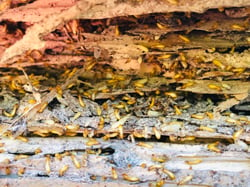 Subterranean termites working
Subterranean termites working
TERMITE LIFECYCLE AND BIOLOGY
Termite damage can occur quickly and with little warning – this is due, in part, to the termite’s ability to rapidly reproduce and grow their colony. A termite’s lifecycle can be broken down into three stages: egg, nymph, and adult. Termite queens can lay up to 30,000 eggs per day and these eggs are fiercely protected by the entire termite colony. When the eggs hatch, immature termites called nymphs will emerge.
Nymphs are nearly translucent in color and look remarkably similar to maggots in this stage. Through the molting process, a nymph will begin to develop an exoskeleton, shed it, and repeat the process up to three times. Nymphs will also grow larger and darker throughout molting until reaching maturity. During the nymph stages, the termites do not eat wood. Instead, the workers of the colony feed them into adulthood.
When the nymphs fully mature, the termites will fall into colony hierarchy and roles. Most of the termites will go on to become worker termites, responsible for the potential destruction of your home. Other termites will be soldiers and some become reproductive termites, known as alates. Interestingly, you can actually discern the termite’s role within the colony by their appearance. Worker termites are wingless and creamy white in color. Soldier termites are also creamy white in color but have an enlarged head that is darker than the rest of their body and has a large pair of mandibles.
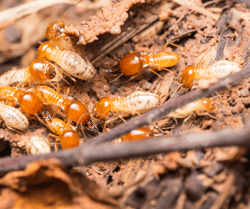 Soldier termites at work
Soldier termites at work
WHAT DAMAGE CAN TERMITES CAUSE?
Depending on the species of termite and the size of the colony, termite damage can be considerable. Because termites feed primarily on wood, termites have the capability of compromising the structural integrity of your home. This means they can jeopardize your home’s integrity, weakening the architectural stability and even rendering structures uninhabitable. A home’s framing can be obliterated by a large colony and walls, ceilings, floors, and subfloors can collapse from catastrophic termite damage. The damage termites can cause should not be underestimated.
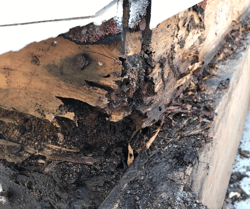 Termite damage
Termite damage
WHAT ARE THE SIGNS OF TERMITE DAMAGE?
Unfortunately, some termite damage does not become apparent until a full-blown infestation occurs. This is especially true for internal damage, as termites typically work from the outside inward. Internal damage nearly always points to an infestation left unchecked and it’s highly probable that there is considerable exterior damage, as well. Luckily, there are some signs of termite damage to look out for to prevent further damage.
- Buckling wood
- Swollen floors or subfloors
- Bulging ceilings
- Damage on walls and ceilings that looks like water damage
- Discolored or drooping drywall
- Visible mazes within walls or furniture
- Peeling paint
- Mud tubes located near the foundation of the home
- Cracked wood furniture or other wooden items
- Small holes in drywall
- A mildew or mold-like scent
- Sudden or overt squeaking in floorboards
- Wing piles left after swarms
If you spot signs of a potential termite infestation in your home, contact a trusted pest professional immediately. Catching an infestation early and before too much damage has been caused is the best way to protect the integrity of your home and avoid shelling out several thousand dollars in repair costs.
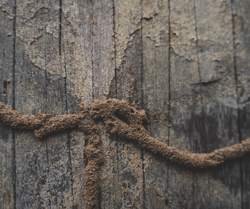 Termite mud tubes
Termite mud tubes
HOW CAN I PREVENT TERMITES FROM DAMAGING MY HOME?
The only way to prevent termite damage is to prevent termites from attacking your home altogether. While certainly easier said than done, there are a few ways that you can help make your home a less easily accessed or hospitable place for termites to hang out. Some prevention tactics include:
- Remove any unnecessary lumber, mulch, wood, or other cellulose-based debris from near the foundation of your home.
- Stack firewood away from the home and ensure the wood is raised off the ground.
- Be mindful of landscaping around the foundation of your home. Wood mulch against your home’s foundation may draw termites near.
- Consider using pine needles or pea gravel in your landscaping.
- Regularly cut and rake any grass near your home.
- Reduce moisture around your home’s foundation by ensuring water from gutters or other drainage is directed away from the home.
- Ensure sprinkler heads are pointed away from the home.
- Utilize vapor blocks to reduce moisture and use dehumidifiers where needed.
- Keep dead trees, rooting wood, and tree stumps away from the home.
- Seal cracks around your home foundation and utilities that may lead to water entry or buildup.
- Turn off outdoor lights at night as they can attract flying termites and swarms.
- Check your roof for signs of water damage, mold, or rot. This is especially important for homes with flat areas of their roof where standing water can accrue.
- Get regular termite inspections from a trusted pest professional.
- Sign up for termite monitoring services from a trusted pest professional.
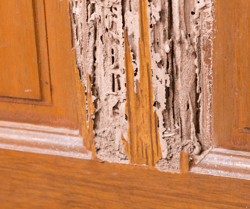 Termite damage to door
Termite damage to door
How to Check your home for termites
Across the United States, termites do more damage to homes every year than all reported natural disasters combined. Spotting infestations before they get serious helps homeowners protect their greatest investment. Through careful inspection, homeowners can catch pest activity early on. Flying swarmers, wood damage, and shelter tubes are telltale signs that termites are present.
Look for Flying Swarmers
Termite colonies' reproductive members, or swarmers, take flight in large groups during the summer to look for places to start new settlements. Winged insects emerging from soil or wood is the easiest way to tell whether termites are active nearby. Even if residents don't notice the pests, their cast-off wings are often left on the floor around doors or windowsills. Since they are drawn to light, these are common entry and exit points.
Identify Damaged Wood
The various kinds of termites damage homes differently. Drywood termites live in moist, tropical zones and leave piles of wood powder or pellets where they burrow. They can also cause wood to take on a blistered appearance by tunneling too close to the surface.
Dampwood termite damage comes in the form of wood that feels soft to the touch. Additionally, moisture-damaged wood is most susceptible to dampwood termite infestation. Wood infested by dampwood termites generally shows no external damage because openings in the wood are plugged with fecal material.
Finally, subterranean termites are much more common. They cannot live in the open air, so they build galleries within timber. Wood that looks fine on the outside may be riddled with tunnels on the inside. To check if an area is infested, tap or probe it with a screwdriver. Severely damaged timber sounds hollow and is easy to pierce. Untreated or moist wood that touches the soil is most likely to be affected. Formosan termites are predominantly soil-residing termites but do form aerial nests.
Observe Shelter Tubes
Termites also build shelter tubes (mud tubes) out of dirt and wood particles that are cemented together by their saliva and other liquids. Their mud tubes allow them to move between their nests and feeding sites without dehydrating. The tubes are about the width of a pencil and brown in color. They are commonly found on foundation walls or slabs, crawl space piers, attics, and floor joists. They may run along flat surfaces or hang down vertically.
To tell whether the termites that built these tubes are still around, scrape off a piece of the mud tube. If the pests later repair the tunnel or build a new one, an active colony is present.
If you suspect termites are damaging your home, please give us a call for a FREE No-Obligation estimate.
Frequently Asked Questions
What are formosan termites?
When most people think of termites, they’re likely thinking of Subterranean termites. These termites are regarded as the most destructive of any termite species and are the most widespread by far. But few people know of a specific subterranean species that is highly invasive and remarkably aggressive: the Formosan termite. Worse yet? Formosan termites may be closer to home than you might think... Read More
How do I Get rid of Drywood Termites?
Termites – a pest dreaded by many homeowners. Relatively common in homes with wooden structures, drywood termites can cause significant damage to both homes and property. When struggling with a drywood termite infestation, time is of the essence. The longer termites are present and allowed to tunnel through wood in or around your home; the more damage may compound... Read More
How Can I Prevent Termites from Damaging My Home?
The average cost of termite remediation can be anywhere from $3,000-$8,000 depending on the extent of the damage. Such remediation costs can be so burdensome due to termites’ ability to attack the structure of a home including ruining subfloors, collapsing floors and ceilings, and even wrecking... the integrity of a roof. Devastating damage can be caused in as little as three years with very few warning signs... Read More
How do I know if I have subterranean termites in my home?
Termites. The word alone is enough to strike fear in homeowners – and for good reason! Termites are among the most destructive household pests. With voracious appetites and the ability to reproduce seemingly overnight, termites can bring even the sturdiest of homes to their knees. The worst part?... Read More